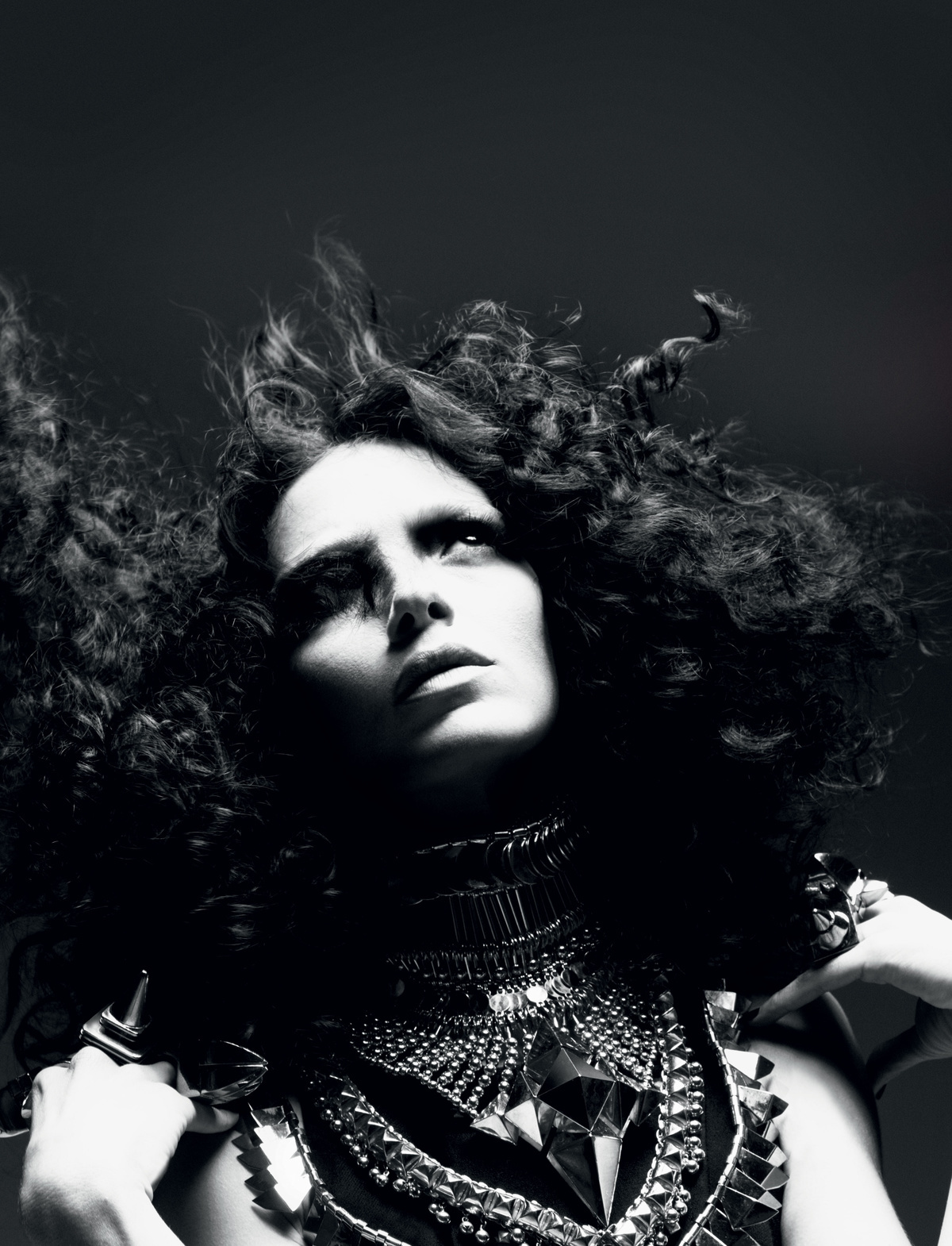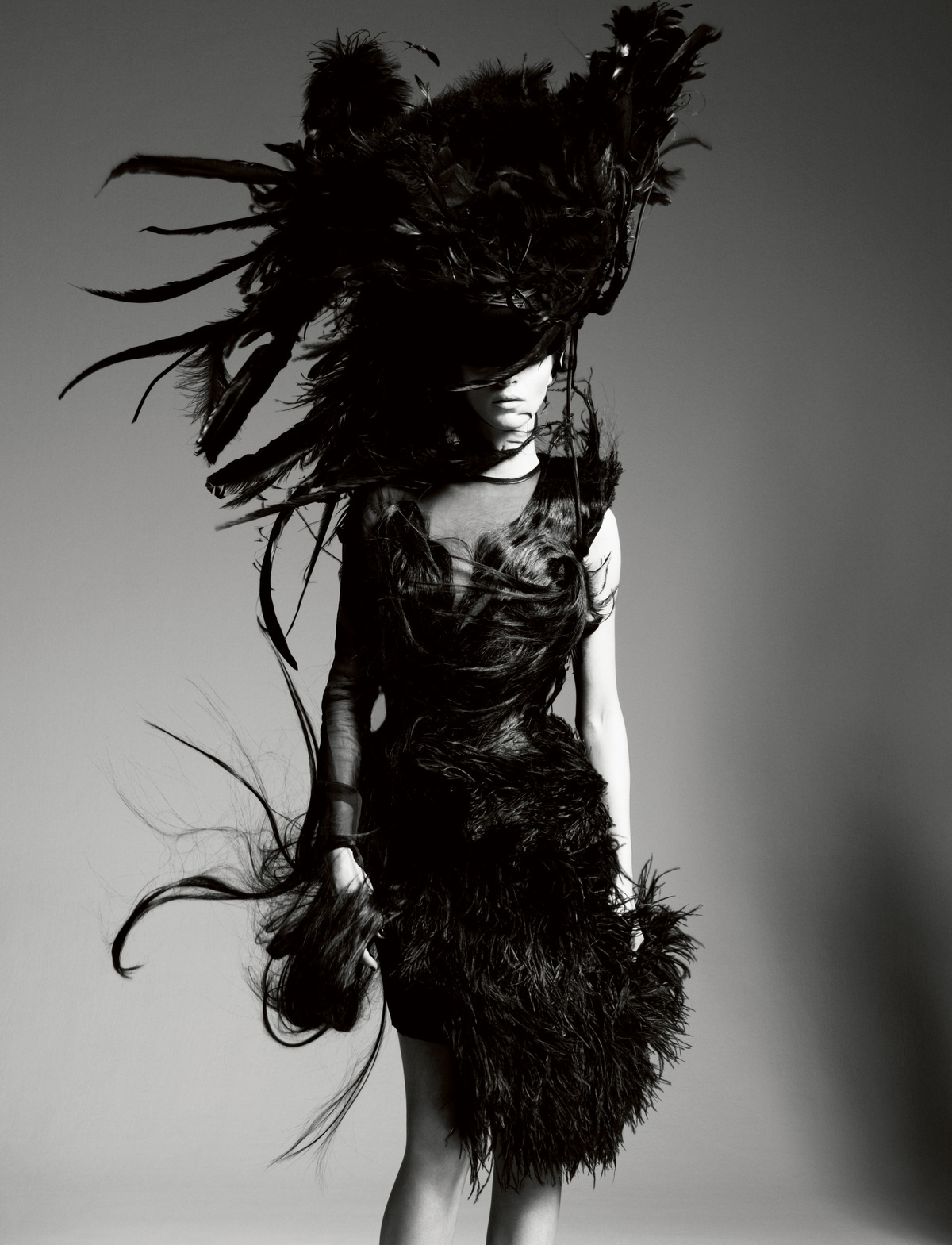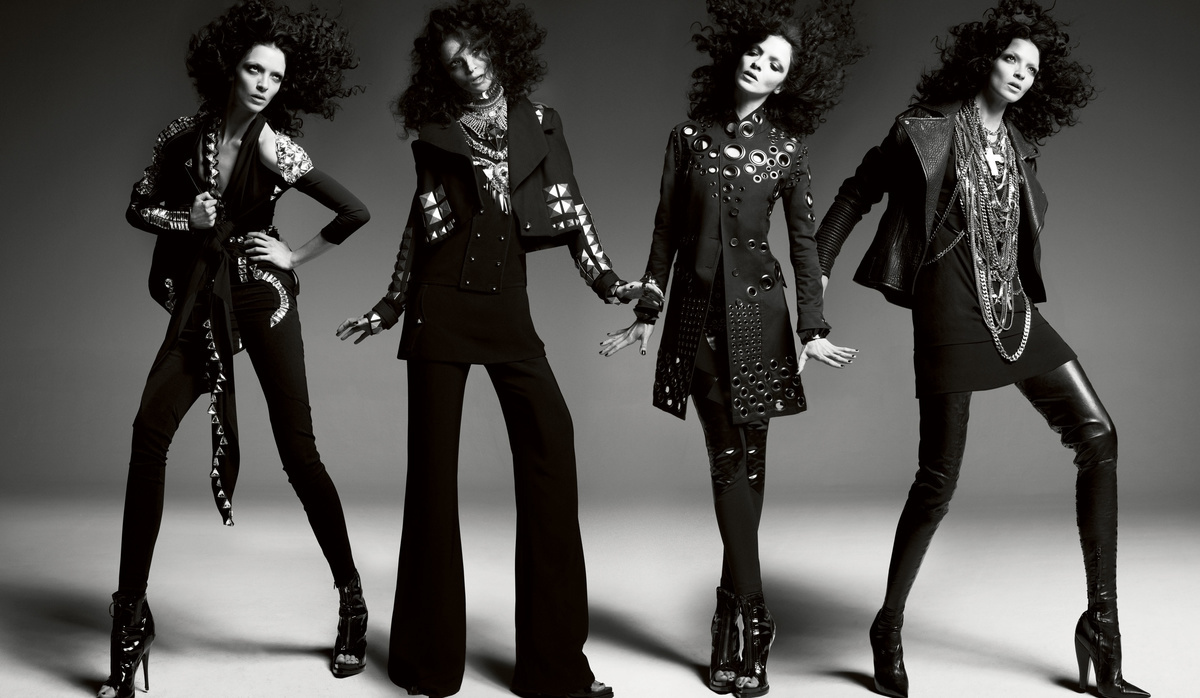Yesterday, MariaCarla Boscono closed his autumn/winter 14 show, slinking down the carpeted runway in a stunning floor-length gown like a gothic, sequined, sea-queen. His muse since he graduated from Central Saint Martins, MariaCarla has been the backbone to his whole career. We find out how the friendship between designer and muse began…
“My style is dark romanticism with a touch of sensuality and religion,” says Givenchy’s Artistic Director Riccardo Tisci. It is a cold December day and we are sat outside the ice rink at Somerset House. It is five years since Tisci, a then little known designer, was plucked from obscurity to helm the house of Givenchy. Today Givenchy is a by-word for cool. Immediately recognisable for its dark, gothic clothes, it is a house where the ‘outsider’ reigns supreme, where beauty embraces differences and grunge is as elegant as glamour. Dressed in black, with a hoodie poking out the top of his jacket and trainers on his feet, 34-year old Riccardo is an unlikely fit for a distinguished French Haute Couture house. Tall, dark and handsome, he wears braces on his teeth, which he flashes when he smiles and smokes a string of cigarettes as we talk.Tisci is one of a handful of designers in the world responsible for all facets of the maison he directs, including ready-to-wear, Haute Couture, menswear and accessories . It is a demanding job and one only made possible thanks to the love and support of Tisci’s tight-knit, south Italian family, Catholic upbringing and muse and best friend MariaCarla Boscono, all of which are integral to Tisci’s identity.
Love is everything. Love for a partner but mostly love for family. It’s a word I use a lot at Givenchy.
Riccardo Tisci’s spring/summer 10 collection for Givenchy cemented the designer’s formidable status. As the final editors secured their seats and the music started, the atmosphere had a palpable electric charge. MariaCarla, Lara Stone, Lakshmi Menon, Iris Strubegger, Magdalena Frackowiak, Meghan Collison and newcomer Ranya Mordanova were amongst the models hand-picked by Tisci to translate his vision. With muted make-up, bleached eyebrows and slick centre-parted hair they marched serenely down the runway like mysterious goddesses or members of an occult from some faraway land. “I was inspired by a masculine wardrobe in an Arabic country,” Riccardo explains. “A super romantic sensuality enhanced with a touch of psychedelic prints.” Championing modern elegance and dark romance, Tisci contrasted the rigid lapels and sharp shoulders of beautifully tailored jackets with goddess- draped chiffon, geometrically cut camisoles, black drop-crotched harem trousers and voluptuously ruffled baby doll dresses to create a vision that was both sexy and sinister. An opulent black and white print from Hubert de Givenchy’s archives, reinterpreted by Tisci for the 21st century enhanced dresses, skin-tight trousers, jackets, shirts, cummerbunds and shoes with almost mathematical clarity. “I wanted to do something pure that represents me,” Tisci explains earnestly, off-setting the harmony with a series of bizarre cone hats; traditional Moroccan headgear simplified into a style he hoped would transform each girl, storm trooper style into a “kind of unicorn”. The critics loved it.

Born in the coastal town of Taranto, in Puglia, Southern Italy, Riccardo’s background is a far cry from the celebrity fashion status he finds himself in today. His father passed away when he was just four years old, leaving his mother to raise him and his eight sisters on her own. “It brings tears to my eyes when I talk about my family, because I have a great family and that’s the luckiest thing in my life,” he says. “My Mum is the most intelligent person I’ve ever met. She’s a classic, proud, Italian Mum.” Riccardo began work aged nine, helping his uncle as a plasterer and a florist. “We may have had no money, but smiles, happiness and freedom have always been in my house,” Riccardo says with passion. “With love you can have so many beautiful things, sometimes you understand that money isn’t everything in life.” At the age of 17, Riccardo left Italy and moved to London, determined to make his fortune and support his family back home. “I didn’t think about wanting to become a designer, I just wanted to become Riccardo, I wanted to grow up and London was where I wanted to be,” he recalls. Despite being unable to speak English, Riccardo embraced his new life in the capital with vigor, securing a bed-sit in Oval and working as a nightclub doorman to make ends meet. Fate intervened two years later when after reading an advertisement on the tube, Riccardo enrolled on a foundation course at The London College of Fashion. Riccardo’s tutor soon spotted his star potential and encouraged him to enroll at St Martin’s, which he did, winning a grant on the strength of his illustration skills. In his final year Riccardo met the then little known Italian model, MariaCarla Boscono, sparking a relationship that was to provide the backbone to Tisci’s whole career.
“MariaCarla represents the reincarnation of my woman,” Riccardo says, evidently smitten. The 29-year old Italian supermodel has been Tisci’s best friend and muse for the past 12 years and looking at the raven-haired beauty it’s easy to comprehend his adoration. “She’s like family to me,” he continues. “We’ve been friends for so long now it feels like love. We’ve travelled together, we’ve done so many things… She’s my guardian angel.”

Riccardo graduated in 1999 and MariaCarla walked in his show. He returned to Italy later that year to work as a consultant for Antonio Berardi, Puma and Coccapani before signing a three-year contract with Ruffo Research. Unluckily for Tisci, the Milanese leather label was declared bankrupt just months before his first show. The devastated Italian travelled to India where he designed a small T-shirt collection in a factory just outside of New Delhi. On returning to Milan he met up with MariaCarla, who was so impressed with the collection she persuaded Tisci to do a show, recruiting Karen Elson, Natalia Vodianova and Frankie Rayder to walk and hand-delivering the invitations herself. “MariaCarla was amazing,” Tisci recalls. “She was getting bigger and bigger and she was walking in about ten shows a day, but in the night she would bring girls to meet me and go flyering.” With help from PR Karla Otto, Riccardo’s first show took place off schedule, in a large, disused garage on the outskirts of Milan. The standing audience – there was no budget for seats – consisted of a roll call of international editors, including Anna Wintour, Carine Roitfeld (who has maintained a close friendship with Tisci throughout his career), Suzy Menkes and i-D’s very own Terry Jones. More of a performance than a runway show, Riccardo’s girls wandered around the vast industrial space, smoking cigarettes, drinking beer and playing catch with oversized black balloons to a backdrop of dramatic lighting, gothic church music and incense. “It really was a moment in fashion history,” Riccardo says. “There was this big buzz about all these top models walking for free for this young designer no one had heard of. The next day I got so many people calling wanting to produce me and wanting to be part of my business.” By his second own-name show six months later, those callers included previous Givenchy boss Marco Gobbetti, who flew Riccardo to Paris the next day, installing him as head of Givenchy Haute Couture, Ready-to-Wear and Accessories five weeks later.
MariaCarla represents the reincarnation of my woman. She’s like family to me. We’ve been friends for so long now it feels like love. We’ve travelled together, we’ve done so many things… She’s my guardian angel.
“I have three countries to thank for my success,” Riccardo informs, lighting another cigarette. “England, because it gave me the support to study, India because it gave me the opportunity to start my own life and my own label [Riccardo returns to India every year to do meditation], and France because it gave me the opportunity with Givenchy.” The appointment was a big gamble for the French couture house and a giant leap in responsibility for Tisci, who is the fourth designer and Central Saint Martin’s graduate to have succeeded Hubert de Givenchy since his retirement in the mid nineties. The prestigious position was initially awarded to John Galliano, who left to take over the helms of Christian Dior in 1996, followed by Alexander McQueen who departed in 2000, followed by Julien MacDonald, who left in March 2001. On arriving at the maison, Tisci was presented with an outmoded system that had been in place since the 1950s and given charge of a skeleton staff, the majority of whom had also been there since Hubert de Givenchy’s reign and were unimpressed with this young boy who had come to take charge. Budgets were slashed, or non-existent and the young designer had never before designed Haute Couture. “I was scared like hell,” Tisci confesses. “I thought why did they pick me? I couldn’t see any connection between me and Hubert de Givenchy, apart from our love of the colour black. Givenchy was on the floor,” he continues, “and if I could not have saved it they would have closed it.” While the press pondered how the young Italian, with his gothic sensibilities could carry on Hubert’s legendary legacy (the couturier was universally admired for his pure lady-like elegance), Marco Gobbetti knew better, and on examining Givenchy’s archives, Riccardo too became aware of a tangible connection. “I was shocked. On looking at the archives I realised that Givenchy was so much more avant-garde than people thought. For all these years people had only associated Givenchy with Audrey Hepburn. Hubert de Givenchy is a genius and on looking at the archives I began to understand the connection between our styles and I found things that could still be very powerful today.” Tisci was the first designer for Givenchy to be invited to meet Hubert de Givenchy himself. An invitation he didn’t take lightly. “I was so nervous!” he exclaims. “Put yourself in my situation. I was just a boy from a little village in Italy!”

A devout Roman Catholic and a firm believer in spirituality, Tisci has tapped into Catholicism since the beginning of his tenure at Givenchy, frequently shrouding his model’s heads and faces in lace and working in a strict black and white colour palette. “I don’t go to church as often as I would like, but I pray every night,” Riccardo informs. “My Mother brought us all up to be very religious. I believe in reincarnation and believe that all of this happened in my life because I always carry with me the soul of my father.” For autumn/winter 08, the Italian designer pinpointed a sombre, ecclesiastical mood with swathes of gilt crucifixes and rosary beads, heavy black lace and high-necked Elizabethan ruffled shirts that he was to return to again and again in his work. Frothy white skirts – seen in spring/summer 10’s collection – and pious yet elegant black evening gowns are other signature saint-like statements. It is with similar regard the designer references Moroccan, North African and Middle Eastern cultures. For autumn/winter 09 Haute Couture, Tisci’s models came swathed in black fabric, their faces, necks and wrists heavily adorned in opulent gold jewellery. Velvet coats and jackets came lavishly adorned in lace and crystals, whilst glittering harem pants and chiffon hoods oozed exotic aristocracy. “I travel a lot,” Tisci explains, “and I’m very attracted to cultures that are very old and very strong, like religion.”
It is little surprise that Tisci has found favour with Queen Rania of Jordan. The fashion forward Monarch is renowned for her conceptual approach to dressing and approached Riccardo directly to design her capsule wardrobe. “When I met her she was wearing a black leather jacket, denim trousers and a very small heel,” he recalls. “I’ll remember her forever. She was super beautiful. It was then I realised a Queen can be modern. I thought, this is couture for me, this is what a Queen should be, a real dynamic woman that represents her country like an ambassador, a modern woman who travels and goes to parties and the openings of museums. Couture should be high quality but it should also show experimentation. Couture’s needs have changed.” 2008 also saw Tisci branch out into the pop world, designing two Givenchy Haute Couture outfits for Madonna‘s Sticky and Sweet world tour.

Tisci inherited Givenchy menswear in 2008, leaving him with artistic control of the entire Givenchy brand. As with womenswear and Haute Couture, Tisci was determined to champion the individual and celebrate a dark, conceptual beauty; a vision he honed with the expert eye of stylist Panos Yiapanis, who not only styles the menswear shows and advertising campaigns but also regularly appears on fashion blogs and best-dressed lists wearing head-to-toe Givenchy. Tisci debuted his first menswear collection for spring/summer 09. Featuring black leather leggings, leather shorts, knee high socks and tuxedos teamed with crisp white shirts it immediately thrust the 50-year old brand firmly into the 21st century. For spring/summer 10, Tisci continued to shape this new masculinity, cross-referencing subcultures and continents. Keffiyeh prints adorned silk shirts and drop-crotch trousers and tartans came embellished with gold studs in a mood that referenced skater-chic, Axl Rose and attitude.

Tisci’s expert eye is also accredited with launching the careers of some of the world’s leading supermodels including Natasha Poly, Lakshmi Menon, Ranya Mordanova and the incredible Lara Stone. “I like to pick girls that give emotion,” Riccardo reveals, “I see girls in a very strange angle that some people don’t see. Girls are not meat in a market.” Instead Riccardo’s girls are both fierce and ferosh. As depicted in Givenchy’s autumn/winter 09 campaigns by Mert Atlas and Marcus Piggott, his proudest advertising campaign to date. With jet-black hair and no eyebrows, MariaCarla, Ranya, Victoria Secrets’ model Adriana Lima, Iris Strubegger and Leonor Scherrer, came transformed into chic Parisian vampires, hungry and ready to pounce. “It is a great pleasure for me to work with Mert and Marcus. I have loved them since I was a student.” The creatives recently completed Givenchy’s spring/summer 10 campaign, starring MariaCarla and Natalia Vodianova alongside male models Emil Dostovic, Simon Nessman, Paris Michael Nicholson and Eduardo Calero. Fresh, graphic and clean, it alludes to early Calvin Klein advertising and lifts the house out of the boudoir and into the studio.
“I would love to have my own casting agency,” Riccardo concludes. “I do love beauty, but I really love strength. In my shows I use super skinny, curvy, black, white, tall, short… it doesn’t matter. All that’s important is that they look like Givenchy.” In five short years, Tisci has performed nothing short of a miracle. He has retained elements of Givenchy’s heritage to keep it grounded, whilst re-writing the house codes with factions of his own personality to apply relevance to the 21st century and this year, for the first time in twenty years, the maison has broken even. “I come from a very tight family, and that’s the way I work at Givenchy. The photographers shooting the advertising campaigns, the models… everyone I work with has become close friends, like family,” he says. So where does he hope to steer Givenchy in the future? “I want to bring back Givenchy’s glory moments of the 50s and 60s.” He also plans to increase Givenchy’s presence in art, film and performance, something we saw evidence of last year when the designer guest-curated an issue of A Magazine. “I’ve been through a lot of shit in my life, so my feet are firmly planted on the floor,” Riccardo concludes. “If you know me, I’m the kind of person that can give you my heart. At the end of the day I’m making clothes with emotion and today I’m very proud, not so much because of my title at Givenchy but because I’m still Riccardo, I didn’t change.”
Credits
Photography Mert Alas and Marcus Piggott
Styling Panos Yiapanis
Hair Luigi Murenu at Streeters NY
Make-up Charlotte Tilbury at Management Artists Organisation
Nail technician Lorraine Griffin using Chanel Black Satin
Photographic assistance Gareth Horton and Maurizio Bavutti
Styling assistance Matt Carroll, Philly Piggott and Hannah Belbern
Make-up assistance Lotten Holmqvist
Hair assistance Akki Shirakawa
Digital technician Timothy Wright
Digital assistance Giovanni Tine
Model MariaCarla at Viva Paris and Riccardo Tisci
